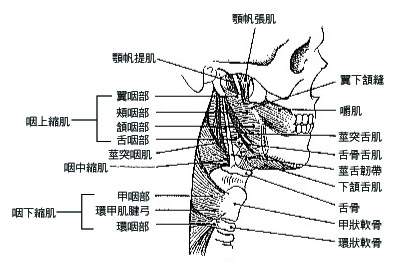
3. 構音相關肌肉群 Muscles involved in the articulatory system
咽部的肌肉 Muscles of the Pharynx : Pharyngeal Masculature
下頷骨的肌肉 Mandibular Elevators and Depressors
臉部的肌肉和嘴唇都是構成發音重要的部分。
The muscles of the facial expression are important for articulation involving the lips.
其中包括了:
輪 頰 肌 (Orbicularis oris)
笑 肌 (Risorius)
頰 肌 (Buccinator)
提 上 唇 肌 (Levator Labi superioris alaque nasi Muscle)
提 鼻 翼 肌 (Leveaor angui oris muscle)
大 顴 肌 (Zygomatic major muscle)
降 下 唇 肌 (Depressor labi inferiooris muscle)
降 鼻 翼 肌 (Depressor anguli oris muscle)
頦 肌 (Mentalis)
頸 闊 肌 (Platysma)
輪頰肌為嘴唇上下方的肌肉,能讓嘴唇的開合及前後伸縮自如。笑肌和頰肌幫助唇的收縮,也支撐了整個口腔的氣體流通。提上唇肌、小 顴 肌、提鼻翼肌的收縮動作會牽動上唇,使之往上移動,而降下唇肌則掌管下唇的收縮及下拉。大顴肌控制嘴角的延展和收縮動作,降鼻翼肌則負責使上下唇上下移動。降鼻翼肌可將嘴角下拉,頦肌可讓下唇向外伸展,頸闊肌可使下頷下移。
Numerous muscles inserts into the orbicularis oris inferior and superior muscles, providing a flexible system for lips protrusion, closure, retraction, elevation, and depression. The risorius and the buccinator muscles assist in the retraction of the lips, as well as support entrapment of air within the oral cavity. Contraction of the levetor labii superioris , zygomatic minor, and levator labii superioris alaeque nasi elevate the upper lip; contraction of the depressor labii inferioris depress the lower lip. Contraction of the zygomatic major muscle elevates and retracts the corner of the mouth, while the depressor labii inferioris pulls the lips down and out. The depressor anguli oris muscle depress the corner of the mouth, the mentalis muscles pulls the lower lip out, and the platysma depresses the mandible.

圖片摘自 http://ha.mtroyal.ab.ca/figs/l23/230202.htm(其他臉部肌肉的圖片也可供參考)
舌的內源肌可相互聯動產生快速精確的構音,不論是語音或非語音。而外源肌則負責整個舌頭的移動,使整體更靈活。
The intrinsic muscles of the tongue interact in a complex fashion to produce the rapid, delicate articulations for speech and non-speech activities. The intrinsic tongue muscles are responsible for precise articulatory performance and the extrinsic muscles of the tongue tend to move the tongue as a unit.
內源肌 Intrinsic tongue muscles
上 縱 肌(Superior longitudinal muscles of tongue)負責將舌和舌尖上提。
Superior longitudinal muscles of tongue are responsible for elevating the tongue or tongue tip.
下 縱 肌(Inferior longitudinal muscles of tongue) 則負責將舌和舌尖下移。
Inferior longitudinal muscles of tongue are responsible for depressing.
橫 走 肌(Transverse muscle of tongue)使舌保持平坦並可將舌彎成槽狀,當其收縮時,舌便窄變長。。
Transverse muscle of tongue can flatten the tongue and is responsible for cupping and grooving of the tongue.
垂 直 肌 (Vertical muscle of tongue)能讓舌頭變扁變寬。
Vertical muscle of tongue can narrow the tongue.
外源肌 Extrinsic tongue muscles
頦 舌 骨 肌(Genioglossus muscles)能使整個舌頭靈活地活動,無論是收縮、吐出或使之下降。
Genioglossus muscles are responsible for tongue body movement and cupping of the tongue. They can retract, protrude, and depress the tongue.
舌 骨 舌 肌(Hyoglossus muscles)負責將舌下壓和提升舌骨。
Hyoglossus muscles are responsible for depressing the tongue and elevating hyoid.
莖 突 舌 肌(Styloglossus muscles)牽引舌向上向後,也可將舌骨及喉頭上提。
Styloglossus muscles are responsible for elevating the posterior of the tongue. They also can elevate hyoid and larynx.
小 角 舌 肌(Chondroglossus muscles)可將舌下移。
Chondroglossus muscles are responsible for depressing the tongue.
舌 顎 肌(Palatoglossus muscles)負責將舌的後方提升,也可使咽部變窄。當其收縮時,舌捲成管狀以利吸吮。
Palatoglossus muscles are responsible for elevating the posterior of the tongue. They also can narrow fauces.

圖片摘自Seikel, et al. Anatomy and Physiology for Speech, Language, and Hearing
下頷包含嚼肌、顳骨肌和內翼肌,而外翼肌則是使下頷突出。下頷的下降賴臼齒與舌骨肌、頦舌骨肌和頸闊肌。而臼齒作咀嚼動作時,需靠咀嚼肌協調而一致的收縮。
Mandibular elevators include the masseter, temporalis, and medial pterygoid muscles, while the lateral pterygoid protrudes the mandible. Depression of the mandible is performed by the mylohyoid, geniohyoid, and plastyma muscles. The grinding action of the molars requires coordinated and synchronizd contraction of the muscles of mastication.



圖片摘自Seikel, et al. Anatomy and Physiology for Speech, Language, and Hearing
嚼 肌 (Masseter)可使下頷上移。
Masseter elevate mandible.
顳 骨 肌 (Temporalis)使下頷上升、收縮與突出。
Temporalis can elevate, retract, protrude mandible.
內 翼 肌 (Medial pterygoid)使下頷上升,並負責側邊的移動及咀嚼。
Medial pterygoid can elevate mandible and is responsible for lateral movement and grinding movement.
外 翼 肌 (Lateral pterygoid)負責嚼動與外突。
Lateral pterygoid is responsible for grinding and protruding.
臼 齒 與 舌 骨 肌 (Mylohyoid Muscle)起於下頷下側到舌骨。因為舌骨是固定的,臼齒與舌骨肌負責下移的動作。
Mylohyoid Muscle originate on the underside of the mandible and courses to the corpus hyoid.With the hyoid fixed in position, the mylohyoid will depress the mandible.
頦 舌 骨 肌 (Geniohyoid Muscle)起於下頷的頦椎,平行地往前二腹肌突出,從內下頷表面深入舌骨。如果舌骨固定,頦舌骨肌的收縮就會使下頷下降。
Geniohyoid Muscle originates at the mental spines of the mandible, and projects parallel to the anterior digastricus from the inner mandibular surface to insert into the corpus hyoid. Contraction of the geniohyoid depresses the mandible if the hyoid is fixed.
頸 闊 肌 (Platysma Muscle)是一種臉部肌肉。
Platysma Muscle : a kind of Muscles of the face.
二 腹 肌 (Digastricus):前腹起於位於二腹肌窩的下頷內,靠近聯合線,而後腹則起於顳骨的乳突。前方組織的收縮會使下頷下降。
Digastricus: Digastricus anterior originates on the inner surface of the mandible at the digastricus fossa, near the symphysis, while the digastricus posterior originates on the mastoid process of the temporal bone. Contraction of the anterior component will result in depression of the mandible.
顎帆提肌使軟顎上升,懸雍垂肌使軟顎成串,顎帆張肌拉緊也 使軟顎縮短。軟顎的下降則是顎舌肌與顎咽肌的作用。
The levetor veli palatini muscle elevates the soft palate, the muscle uvulae bunches the soft palate, and the tensor veli palatini tenses and shortens the palate. The soft palate is depressed by means of the palatoglossus and palatopharyngeus.
顎 帆 提 肌 (Levetor veli palatini muscle)起於耳咽軟骨內側同附近顳骨岩部動永管前,向內下行位於咽上縮肌上部內面,兩側肌肉會合於顎腱膜互相融合,收縮時關閉鼻咽腔及輔助擴張耳咽管。
懸 雍 垂 肌 (Muscles uvulae)起於顎骨之後鼻棘於軟顎中間向後行最後端聯合成垂狀。
顎 帆 張 肌 (Tensor veli palatini muscle)如扇狀,起於翼突內板舟窩、蝶骨棘及耳咽管軟骨外側,前一部下行集中成肌腱繞翼鉤,在一起伸張形成顎腱膜,構成軟顎前部,收縮時使耳咽管軟骨向外拉而擴張。
顎 舌 肌 (Plataglossus muscle) 起於舌邊形成顎舌弓(前柱)向上止於顎腱膜前部,左右於中間聯合。
顎 咽 肌 (Palatopharyngeus muscle)起於咽縫下端吉甲狀軟骨後沿,垂直向上走,形成顎咽弓(後柱)而進入軟顎,分兩組,一組在顎帆提肌外側止於顎腱膜前端上部,另一組較靠下在顎帆提肌內側與對側融合。

圖片摘自Seikel, et al. Anatomy and Physiology for Speech, Language, and Hearing
咽縮上肌輔助顎咽的閉鎖,而咽上縮肌和咽縮中肌使食物蠕動較容易。環狀咽肌是肌下縮肌中的一個組織,形成食道的肌肉。耳咽管肌的纖維與咽上縮肌相混後提供咽管壁一個輔助。莖突咽肌輔助喉頭的上升。
The superior pharyngeal constrictor assists in gaining velopharyngeal closure, while peristaltic movement of food is facilitated by the middle and inferior pharyngeal constrictors. The cricopharyngeal muscle, a component of the inferior constrictor, forms the muscular orifices of the esophagus. Fibers of the Salpingopharyngeus intermingle with those of the superior contrictors, providng assistance in elevation of the pharyngeal wall. The Stylopharyngeus assists in elevation of the larynx.
咽 上 縮 肌 (Superior pharyngeal constricteor)雙側肌肉起於翼板內面下側和翼鉤、翼突下頷縫、下頷後面及舌根側。
咽 中 縮 肌 (Middle pharyngeal constrictor) 起於舌骨大小角肌纖維向後於中間會合。
咽 下 縮 肌 (Inferior pharyngeal constrictor) 起於甲狀軟骨側面斜線上及環狀軟骨測,上部肌纖維向後上會合,下部肌纖維水平向後也稱為環咽肌,且同食道環形肌揉合。
環 狀 咽 肌 (Cricopharyngeal muscle)
甲 狀 咽 肌 (Thyropharyngeal muscle)
耳 咽 管 肌 (Salpingopharyngeus)
莖 突 咽 肌 (Stylopharyngeus muscle)

咽部肌肉圖(側面觀)
咽部肌肉圖(後面觀)
圖片摘自張斌《耳鼻喉科學》
以上摘自Anatomy and Physiology for Speech, Language, and Hearing. (written by John A. Seikel, Douglas W. King, and David G. Drumright)